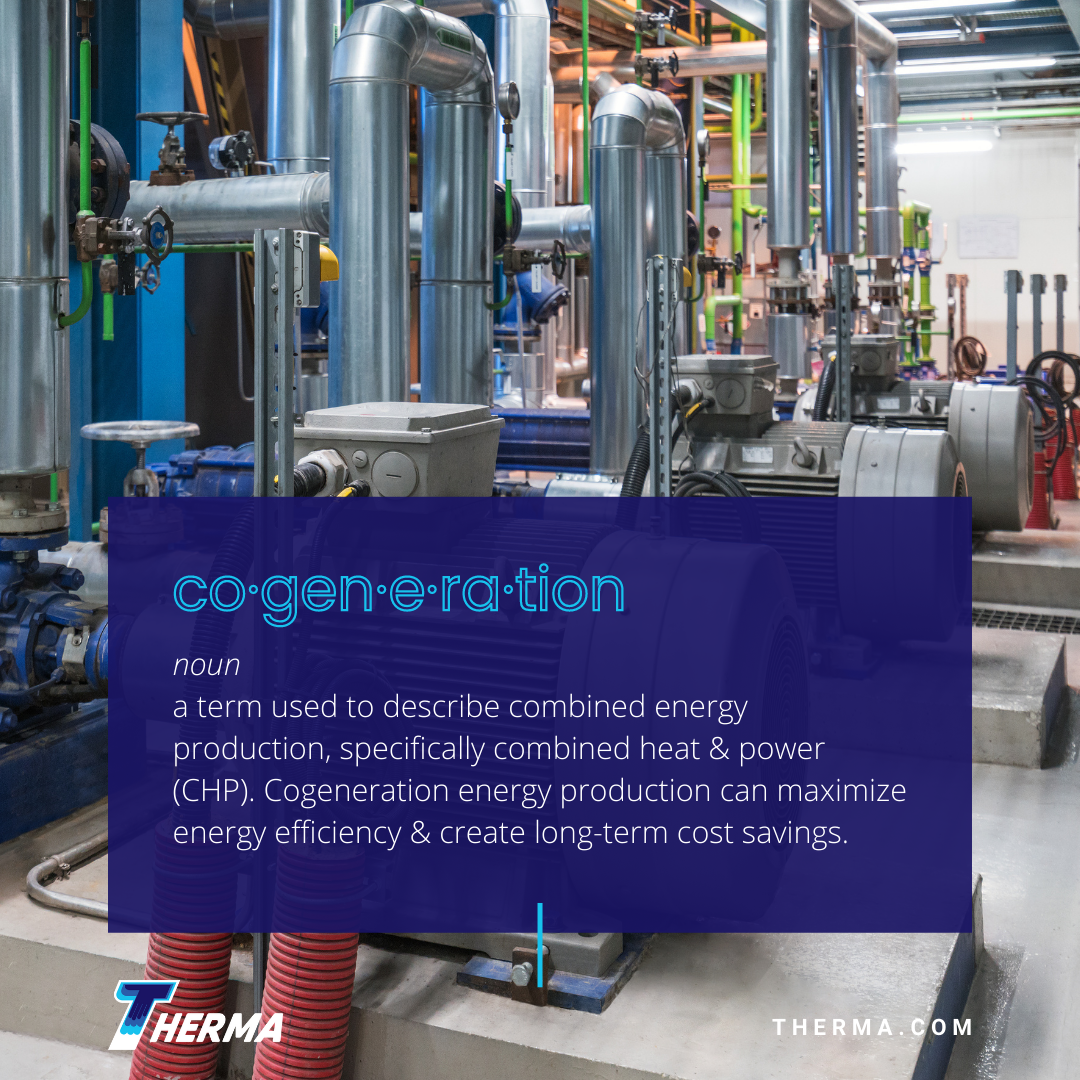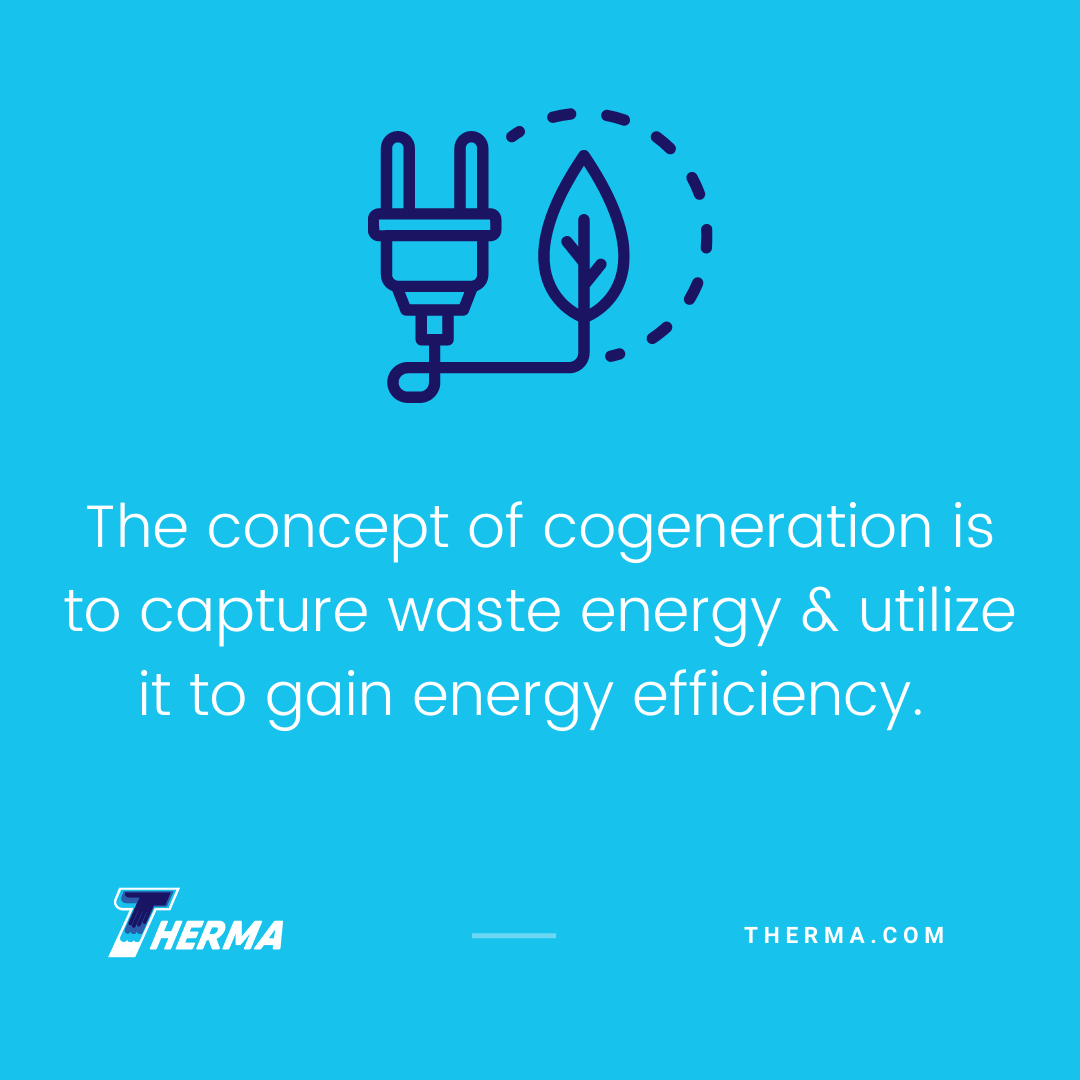by Ali Kriscenski
Cogeneration is a term used to describe combined energy production, specifically combined heat and power (CHP). It is a strategic approach to operations that can be applied to a wide variety of industries. Cogeneration energy production can maximize energy efficiency and create long-term cost savings.
How Energy Cogeneration Works
In energy production, systems that produce electricity also produce waste heat or exhaust. Cogeneration is a way to utilize that waste energy and divert it into additional energy production. Heat recovery can be used in buildings and facilities of all scales.
In residential applications, energy recovery ventilators (ERVs) can capture waste heat in ventilation and apply it to incoming air while maintaining the building’s air balance. At a larger scale, on-site energy production for electricity produces large amounts of exhaust. Mechanical engineers can assess a system’s waste energy and design a CHP system to capture waste heat and utilize it on-site.

Types of CHP Systems
Cogeneration systems can be designed for both new and existing facilities. The system design is a response to the type of facility and site conditions, The two most common CHP configurations are:
- Combustion turbine, or reciprocating engine, with heat recovery unit
- Steam boiler with steam turbine
With a combustion turbine or reciprocating engine CHP system, the excess heat can be recovered and used to create steam or hot water. A steam turbine system produces excess steam which can be captured and used to generate energy. Both types of systems use excess energy from electricity generation to create thermal energy for heating and cooling.
Benefits of Cogeneration
The concept of cogeneration is to capture waste energy and utilize it to gain energy efficiency. The benefits are a combination of increased operational efficiencies and reduced environmental impacts.
Operational Efficiency
Investment in a cogeneration system can create significant long-term savings through reduced energy waste, increased energy efficiency and cost savings. The reduced reliance on a local energy grid translates into lower operational costs. Incentives aimed at furthering uptake include local utility rebates and federal tax credits, which offset the upfront investment and shorten the span for a return on investment.
The most reliable source for energy incentives is the Database of State Incentives for Renewables & Efficiency (DSIRE).
Increased Energy Independence
As many businesses have embraced specific environmental and sustainability goals, the idea of energy independence has also gained more attention. The impacts of natural disasters such as hurricanes, floods or severe winter storms have made it necessary to reassess energy production, distribution and storage.
CHPs are highly resilient to weather events compared to other distribution options. These systems can start and operate in “island mode” during local utility power outages. For facilities that create on-site power, the operational continuity has more predictability. Additionally, the capacity for emergency power generation provides a means to minimize external disruptions and provide backup power for routine maintenance.

Environmental Advantages
Energy cogeneration capitalizes on synergies to improve energy efficiency. By capturing waste energy, CHPs reduce emissions including carbon, and pollutants. In fact, new CHP systems are expected to create a net reduction in carbon emissions over the life of the system, and in some instances reduce annual carbon emissions by 50%.
Cogeneration systems offer flexibility in the primary fuel source. For example, a system could run on biogas which is another waste byproduct. With renewable fuel options, including biogas, renewable natural gas (RNG) or hydrogen, cogeneration systems can be an extremely environmentally conscious option for energy production.
Where CHP Systems Make Sense
As building and facility operations start to incorporate resiliency strategies into capital investments, cogeneration systems make sense. The reliability of CHPs to provide electricity and heating or cooling independently from local energy grids can be particularly useful to hospitals, residential healthcare facilities and universities. They can also reduce the impact severe weather events have on critical supply chain efficiencies by limiting disruption of manufacturing and production of food, medical supplies and safety products.
With proper design, system controls, and clear operational goals, a CHP system may be an investment that can help your facility meet long-term business objectives. With successful installations of CHPs at hospitals, universities, data centers and manufacturing facilities, the uptake of this technology is expanding into hospitality, agriculture, and even the residential sector.
Cogeneration with Therma
By taking a survey of your existing energy systems, facility requirements and operational goals, you can start to determine if a CHP system is right for your building. A look at the state and federal incentives, as well as consulting with an energy expert, can help narrow in on the financial aspects of a cogeneration system. Contact an energy specialist today >>
Ali Kriscenski was trained in high-performance building design at Boston Architectural College. She has worked with leading architecture and construction firms in NYC and New England and served on the executive team at the Forest Stewardship Council International. She was the managing editor at Inhabitat and has worked pro bono for the Green Building Institute, ISEAL Alliance and Habitat for Humanity.
Sources
US Environmental Protection Agency (EPA) – What is CHP?
CHP Alliance – CHP and a Changing Climate: Reducing Emissions and Improving Resilience
U.S Department of Energy – Better Buildings: Distributed Energy Resources Disaster







